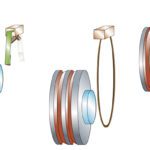Moog Focal, an international ocean technology company based in Dartmouth, Nova Scotia, Canada, is undertaking further expansion into the renewable energy sector. As a result, the company is hiring to fill different roles that will support their expected growth in renewable energy and other business areas. Moog is relocating the production of a specialized slip […]
Connections + Sliprings
Power over Ethernet (PoE) and M12 connectors in motion designs
Though the internet of things is most visible to laymen in consumer devices, the IIoT is massive. The majority of applications are in business, factory, and healthcare settings … and more than a third of the nearly $6 trillion IoT market is in manufacturing. Connectivity is the basis of all this IIoT — providing the […]
What is Ecolab certification for automation components?
In applications that involve wet or humid environments — especially those in the food and beverage industry — a component’s IP (International Protection) rating for ingress of dust and water is an important factor in its selection. But even if a component is rated as dust-proof and protected against the forceful water jets used during washdown […]
Part 3: Trends in Ethernet, PoE, IO-Link, HIPERFACE, and single-cable solutions
As we explored in Part 1 and Part 2 of this six-part series, machine designs are evolving with wireless connectivity, cloud-based operations, and open programming. In this installment, we explore how Ethernet has continued its expansion in industrial connectivity. We also detail increasingly useful cable types for IO-Link and HIPERFACE … as well as cross-network […]
Electric slip rings: 5 things to know about brushes, voltage drops, and noise mitigation
Here we outline five things to know about electrical slip rings and their brushes, voltage drops, and noise mitigation. Also be sure to check out the FAQs: What are slip rings and why do some motors use them? and What’s the difference between electromechanical and fiber-optic slip rings? 1. The three main brush technologies in electric […]
Standard versus custom slip rings — and inductive, capacitive, wetted mercury variations
Slip-ring variations abound — and the advanced components come in bore sizes from half an inch to many feet in diameter — for medical-imaging machines designed to service livestock, for example. But options go beyond mere scale. So how do OEMs and design engineers choose between standard and custom options … and what are other […]
Where are slip rings used? Common markets and applications
Slip rings excel in myriad designs that include a rotating base or platform — including industrial equipment such as index tables, winders, and automated welders. Wind turbines are another key application — as are medical applications for MRI and CT imaging. Slip rings also work at the pivot point of closed-circuit security cameras. Slip rings […]
New hybrid cable from igus handles both power and feedback signals
The new CF280.UL.H cable from igus is a hybrid servo cable offered as an expansion to the chainflex line of cables for moving applications. The flexible cable can deliver motor power and feedback functions through a single cable. Hybrid cable technology was introduced by drive manufacturers to streamline their cable connections to eliminate the encoder […]
What’s the difference between electric and fiber-optic slip rings?
Design engineers identify the need for a slip ring in the very first stages of the design process — as usually there are no viable alternative solutions. Of course, while engineers know near the beginning of the design process whether they need a slip ring, the slip-ring design details are usually developed and finalized with […]
Electrical power and signals through a slip ring: Where do they go?
Slip rings — also called electric swivels, collector rings, and rotary electrical joints — are electromagnetic devices of electromechanical, fiber-optic, or even non-contacting inductance and capacitance subtypes that transmit power and data signals between a rotating machine segment and a stationary segment. Of course, power transmission is associated with higher voltage and higher current than […]










